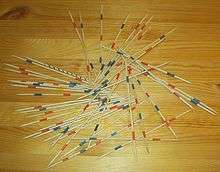Mikado (game)


Mikado is a pick-up sticks game originating in Europe. In 1936 it was brought from Hungary to the USA and was mostly called pick-up sticks.It is a trivial game of India too played in country side since it was named as MIKADO .This term is not very specific in respect to existing stick game variations. Probably the "Mikado" name was not used because it was a brand name of a game producer. The game got its name from the highest scoring (blue) stick "Mikado" (Emperor of Japan). The buddhistic Chien Tung also contains a stick called "emperor".
The house of "Tsuchimikado" adapted in the 16th century some culture, possibly also the "Chien Tung" oracle. Maybe in the course of Japonism in the 19th / 20th century the "Zitterwackel" game had changed to "Mikado" (probably first named "Tsuchimikado").
Rules
Classic Mikado consists of 41 sticks. They are coded with different values that have a total of 170 points and are around 15 cm long.
| Name | Traditional wood type | Coding | Point value | Number of sticks |
|---|---|---|---|---|
| Mikado | walnut | blue | 20 pts | 1 |
| Mandarin | cherry | yellow/black, middle wide two narrow stripes on the ends | 10 pts | 5 |
| Bonzen (jp. bouzu) | oak | orange, five stripes | 5 pts | 5 |
| Samurai | beech | green, three stripes | 3 pts | 15 |
| Kuli (cn. guli) / Worker | ash | red, two stripes | 2 pts | 15 |
The sticks are bundled and taken in one hand that touches the table/ground. The release creates a circular jumble. Now one stick after another should be taken up without moving/touching others. The take away could be by hand, possibly through pressing on a stick's tip or if one has already picked up a special stick (Mikado/Mandarin), it could be used as a helper, possibly to throw up another stick.
It is allowed to stand up on but not to leave the own place. A bad throw could be rerun and the rules should be kept strict in respect to moving sticks to enjoy the game.
On a fault the turn ends (the last stick taken is not counted). The next player bundles and drops the sticks again. After several rounds, normally five, the one with the highest score is the winner.
Rule Variations
- The starting player could be determined with a dice
On a player's turn:
- the sticks are rebundled and dropped
- the stack is taken over from the previous player
Allowed helpers:
- only the Mikado if the player has at least one of all other sticks (Kuli, Samurai, Bonzen, Mandarin)
- Mikado (traditional)
- Mikado / Mandarin (simplified)
- Mikado / Mandarin / Bonzen (casual)
The last stick taken when the stack moves:
- added to the score
- not added
- not added and drop immediately (stack take over variant)
- The exact sequence of Kuli, Samurai, Bonzen and Mandarin may double the points of a turn.
- A player who does not use the correct helper may lose all points of the actual turn.
- in the variation in the US, the person to the left of the player turn drops the sticks for the player. This eliminates the potential for an illegal drop
Types of Mikado
Classic Mikado
Classic Mikado is typically made from beech wood.
Sizes:
- standard: length 17 cm, mm thick
- large: length 28 cm, mm thick
- super: length 50 cm, 8 mm thick
The large and super variants may use the 26 sticks Giant Mikado variant.
Mini Mikado
Made of 31 toothpicks painted in the middle. The game has a total of 145 points. name / coding / value / number of the sticks:
- Mikado, 1 blue stripe, 20 points, 1 stick
- Mandarin, 3 yellow stripes, 10 points, 5 sticks
- Bonzen, 2 orange stripes, 5 points, 5 sticks
- Samurai, 3 green stripes, 3 points, 10 sticks
- Kuli, 2 red stripes, 2 points, 10 sticks
Rules and values are the same as with normal Mikado sticks.
Giant Mikado
This type is usually used for outdoor use. There are 26 sticks with a length of 93 cm and 10 mm diameter. The game has a total of 200 points.
Name Value Number of the sticks Mikado 50 points 1 stick Mandarin 10 points 5 sticks Samurai 5 points 10 sticks Kuli 5 points 10 sticks
Rules and markings are the same as with normal Mikado sticks. The play is more enjoyable on a flat and fixed table.